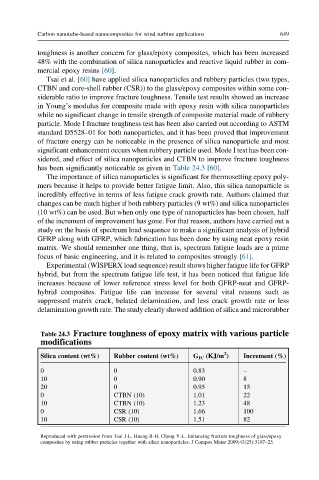Page 706 - Polymer-based Nanocomposites for Energy and Environmental Applications
P. 706
Carbon nanotube-based nanocomposites for wind turbine applications 649
toughness is another concern for glass/epoxy composites, which has been increased
48% with the combination of silica nanoparticles and reactive liquid rubber in com-
mercial epoxy resins [60].
Tsai et al. [60] have applied silica nanoparticles and rubbery particles (two types,
CTBN and core-shell rubber (CSR)) to the glass/epoxy composites within some con-
siderable ratio to improve fracture toughness. Tensile test results showed an increase
in Young’s modulus for composite made with epoxy resin with silica nanoparticles
while no significant change in tensile strength of composite material made of rubbery
particle. Mode I fracture toughness test has been also carried out according to ASTM
standard D5528–01 for both nanoparticles, and it has been proved that improvement
of fracture energy can be noticeable in the presence of silica nanoparticle and most
significant enhancement occurs when rubbery particle used. Mode I test has been con-
sidered, and effect of silica nanoparticles and CTBN to improve fracture toughness
has been significantly noticeable as given in Table 24.3 [60].
The importance of silica nanoparticles is significant for thermosetting epoxy poly-
mers because it helps to provide better fatigue limit. Also, this silica nanoparticle is
incredibly effective in terms of less fatigue crack growth rate. Authors claimed that
changes can be much higher if both rubbery particles (9 wt%) and silica nanoparticles
(10 wt%) can be used. But when only one type of nanoparticles has been chosen, half
of the increment of improvement has gone. For that reason, authors have carried out a
study on the basis of spectrum load sequence to make a significant analysis of hybrid
GFRP along with GFRP, which fabrication has been done by using neat epoxy resin
matrix. We should remember one thing, that is, spectrum fatigue loads are a prime
focus of basic engineering, and it is related to composites strongly [61].
Experimental (WISPERX load sequence) result shows higher fatigue life for GFRP
hybrid, but from the spectrum fatigue life test, it has been noticed that fatigue life
increases because of lower reference stress level for both GFRP-neat and GFRP-
hybrid composites. Fatigue life can increase for several vital reasons such as
suppressed matrix crack, belated delamination, and less crack growth rate or less
delamination growth rate. The study clearly showed addition of silica and microrubber
Table 24.3 Fracture toughness of epoxy matrix with various particle
modifications
2
Silica content (wt%) Rubber content (wt%) G IC (KJ/m ) Increment (%)
0 0 0.83 –
10 0 0.90 8
20 0 0.95 15
0 CTBN (10) 1.01 22
10 CTBN (10) 1.23 48
0 CSR (10) 1.66 100
10 CSR (10) 1.51 82
Reproduced with permission from Tsai J-L, Huang B-H, Cheng Y-L. Enhancing fracture toughness of glass/epoxy
composites by using rubber particles together with silica nanoparticles. J Compos Mater 2009;43(25):3107–23.

